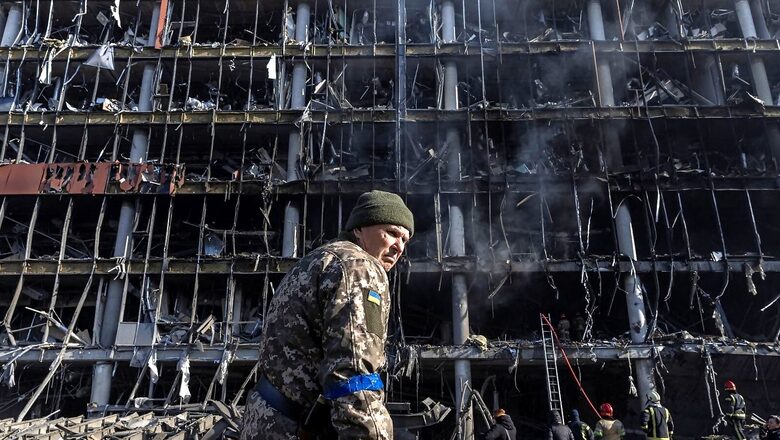
views
Earlier last month, French President Emmanuel Macron had suggested that the “Finlandisation of Ukraine”, a strict policy of neutrality with its origins in the Cold War, could be one of the ways for defusing tensions with Russia. He denied it later. This was a time when President Vladimir Putin’s troops had stepped up military activity on its shared border with Ukraine, while the United States was issuing warning after warning that Russia will soon attack its eastern European neighbour.
It’s almost a month to the day Russia invaded Ukraine and several rounds of talks between the two countries have not yielded significant results. In fact, the Kremlin on Friday said it wanted ongoing diplomatic talks with Ukraine to be more “active and substantive”.
But, after Macron’s statement, the concept of Finlandisation is once again being seen as a “compromise” for eastern Europe.
Russia’s “reason” to launch its “military operation” against Ukraine is the threat of the country joining NATO (North Atlantic Treaty Organization). But, last week, Ukrainian President Volodymyr Zelenskyy said his country will not be part of the western military alliance. Despite that, Ukraine has been known to be a close ally of NATO, which is also helping the country with military firepower in the ongoing conflict.
According to a report published in The Indian Express, Finlandisation has been suggested as a model in 2014 as well, when Russia annexed Crimea and fighting broke out in the eastern Donbas region. But, the report stated, this could be complicated at this stage when Russia has already destroyed significant parts of Ukraine by steady and intense shelling and air strikes. In such a scenario, and with Russia’s worsening ties with superpower United States, Finlandisation could cease to be an option to manoeuvre the conflict towards a definitive end. In a latest development, the Kremlin seems to have taken American President Joe Biden’s comments about Putin being “a murderous dictator” as a serious affront. Biden called the Russian president a “thug” waging an “immoral war” against Ukraine.
‘Finlandisation’ – the meaning
According to the Oxford dictionary, Finlandisation is “the process whereby a country is induced to favour, or refrain from opposing, the interests of a more powerful country, despite not being politically allied to it (originally with reference to the influence of the former Soviet Union on its neighbour Finland)”.
The term is increasingly becoming a buzzword in the Russia-Ukraine conflict, since it provides a general sense of a road to “neutrality” in a conflict where Ukraine seems to be stuck between two more powerful countries — seemingly backed by the United States and invaded by Russia, the two major parties to the Cold War from 1945 and 1990.
An expert in foreign policy and the end of the Cold War, Matti Pesu from the Finnish Institute of International Affairs, says the term Finlandisation may be a suggested solution in the ongoing crisis between Russia and Ukraine but, in Finland, it has a negative connotation due to its effects on the country’s domestic politics. In his article, ‘Finlandisation’ of Finland: The Ideal Type, the Historical Model, and the Lessons Learnt’, Pesu writes that the country’s Cold War experience often appears as a success. The country preserved its democratic system, prospered economically and strengthened its international status, he writes.
But Pesu also talks about whether the strategy can be too “dangerous” in a situation as complicated as the Cold War, or even the Russia-Ukraine situation that is only worsening due to Putin’s intensifying military assault tactics. Seen or even understood as a policy of collaboration and friendship, Finlandisation is hence seen as a “strategy of accommodation” in an almost-nod to India’s long-adopted policy of non-alignment.
Finlandisation, however, is rooted in the Agreement of Friendship, Cooperation, and Mutual Assistance (also known as the YYA Treaty) of 1948, signed three years after the Cold War began and the basis of Finland’s relations with the Soviet Union from 1948 to 1992.
The treaty mostly lays out terms of how Finland must remain “true to its obligations as an independent state” by repelling an attack by any US allies if the country or even the Soviet Union (through Finnish territory) is attacked by any US allies.
Where does Finland stand now
But, the Russian invasion has changed a lot when it comes to the Nordic region even as Finland witnesses a rising number among its population calling to join the NATO. The situation was starkly different through the Cold War and the decades since. But Finns, and even Swedes, now feel that they will be better off joining NATO.
The security outlook in Europe, meanwhile, has changed with many countries in the European Union supporting Ukraine with arms and ammunition, as well as humanitarian aid during the crisis. Finland and Sweden, known as the Nordic neutrals, broke their policy of not providing arms to countries at war by sending assault rifles and anti-tank weapons to Kyiv.
A poll commissioned by Finnish broadcaster YLE this week showed that, for the first time, more than 50 per cent Finns support joining the western military alliance. Sensing a shift, the Russian foreign ministry also voiced concern over its Nordic neighbours. The Kremlin called the move to supply arms an effort by the US and some allies to drag Finland and Sweden into NATO, and warned that Moscow will be forced to take retaliatory measures if they joined the alliance.
Finland has a long-drawn history of conflict with Russia despite its neutrality during the Cold War. Finns have taken part in dozens of wars against Russia for centuries as part of the Swedish Kingdom, and as an independent nation during the world wars, including two fought with the Soviet Union from 1939-40 and 1941-44.
Post-war, however, the course of pragmatic political and economic ties with Moscow gave birth to Finland’s security policy, through which it remained militarily non-aligned and a neutral buffer between East and West. But in 1995, Finland put an end to traditional neutrality by joining the EU and deepening cooperation with NATO. But, even then, a majority of its population was firmly against full membership in the western alliance until now.
“It’s a very significant shift,” said Pesu. “We’ve had a situation in the past 25 to 30 years where Finns’ opinions on NATO have been very stable. It seems now to have changed completely,” he added.
Pesu further said no such similar shift in public opinion took place after Russia’s 2008 war with Georgia and the 2014 annexation of the Crimean Peninsula, so this was an exception.
While Finland may be an important partner for NATO in the Baltic Sea area, where Russia has substantially increased military manoeuvres in the last decade, the country has strongly stressed that it is up to it alone to decide whether to join the military alliance.
Finnish President Sauli Niinisto had said the country’s “freedom of choice” included the possibility of military alignment and applying for NATO membership, while Prime Minister Sanna Marin agreed that the recent events had been a “game-changer”.
“Together we see that the security situation has changed remarkably since Russia attacked Ukraine. It is a fact that we have to acknowledge,” Marin had said.
The Finnish government has taken a strong stance against Russia’s warnings that there would be “consequences” if the country joined NATO. Finland has a 1,340-km land border with Russia, the longest border shared by any European Union member state and Russia.
So, will Finlandisation work for Ukraine?
The question now remains: if the Finnish government has taken such a strong stance, where does it leave war-torn Ukraine in diplomatic talks with its aggressor?
It is obvious that Ukraine will not be joining NATO or EU anytime soon. So then, for Ukraine, keeping its head down may not be the best recourse. According to security and foreign policy experts, Finlandisation only means that the eastern European country would be giving away an essential fragment of its core democratic ethos for Russia to do as it pleases.
Experts said the policy of neutrality may have worked at the beginning of the conflict, but the present situation was fraught with peril. Ukraine has already witnessed large-scale devastation at the hands of Russian troops. Thousands have fled conflict areas while hundreds including children have been killed in military strikes, as per United Nations. Ukrainians are also fighting back tooth and nail, led by President Volodymyr Zelenskyy.
At such a stage, adopting a policy that essentially defines a superfluous “friendship” should never be considered as a solution, experts added.
But, there is also a view that the Finnish model is ideal for Ukraine with respect to EU as well as Russia. If the Ukraine war comes to a negotiated end, the US can prove to be an influential ally so as to enable Ukraine to be “truly independent and territorially undivided”, as per an editorial in the Financial Times written back in 2014 during the Crimean crisis. The op-ed titled ‘Russia needs to be offered a ‘Finland option’ for Ukraine’ states that Ukraine could pursue policies similar to those so “effectively practised” by Finland during the Cold War.
Such a negotiation, however, may still compromise Ukraine’s sovereignty to a large degree even with the might of the US behind it. According to a report published by Boston Globe, some portion of contested provinces in the eastern part of the country, such as Donetsk and Luhansk, may have to be ceded to Russia as possession is nine-tenths of the law. The Putin-led country may also figure in the Black Sea in such a negotiation and will ask for a guarantee that Ukraine stop working closely with NATO.
Also, Finns see the term as offensive reminding them of a time when their government was at the beck and call of the Soviet Union. The Boston Globe article also states that back then, Finnish governments never condemned the Russian invasions of Hungary (1956), Czechoslovakia (1968), or Afghanistan (1979).
Pesu is quoted in this report, too, as saying: “Nothing should be imposed on the Ukrainians. It’s up to them to decide what their foreign policy will be. Finland’s Cold War experience is one model of how a smaller country can navigate in a challenging geopolitical environment. You should never compromise the core of your democracy, but there are lessons learned on how to be flexible.”
With inputs from the Associated Press
Read the Latest News and Breaking News here

















Comments
0 comment